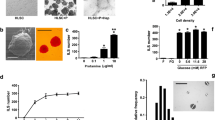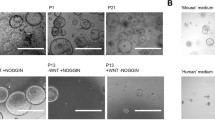Abstract
Currently there is no good hepatocyte model for studying growth hormone (GH) function that reflects its normal physiological roles. Here we report the establishment of a functional hepatocyte cell line, SDRL-1, from the liver of young male spontaneous dwarf rats (SDR), with isolated GH deficiency. This line has been maintained in Dulbecco’s Modified Eagle Medium (DMEM)/F12 medium supplemented with 10% fetal bovine serum (FBS) with retention of a near diploid karyotype for extended periods of time. When grown as a monolayer sheet, it displayed a pavement-like appearance and contact inhibition. These cells have a poorly developed rough endoplasmic reticulum (r-ER), few mitochondria and glycogen granules, and produce a small amount of albumin and α-fetoprotein, that is enhanced when grown on a collagen gel sponge. Human recombinant GH stimulated JAK2 and STAT5b tyrosine phosphorylation and IGF-I production in a concentration-dependent manner. When the cells were cultured with GH-supplemented medium, the number of mitochondria and glycogen granules increased together with the r-ER and Golgi apparatus. A number of microvilli were observed on the surface of the cultured cells, further suggesting that this cell line is composed of normally functioning hepatocytes. In summary, we established a novel hepatocyte cell line (SDRL-1), that appears to display normal function, which we propose can serve as a good in vitro model for studying GH-target organ interactions.
Similar content being viewed by others
References
Brameld JM, Weller PA, Saunders JC, Buttery PJ, Gilmour RS. Hormonal control of insulin-like growth factor-I and growth hormone receptor mRNA expression by porcine hepatocytes in culture. J Endocrinol 1995; 146: 239–45.
Scott CD, Martin JL, Baxter RC. Rat hepatocyte insulin-like growth factor I and binding protein: effect of growth hormone in vitro and in vivo. Endcrinology 1985; 39: 1102–7.
Conover CA, Baker BK, Bale LK, Clarkson JT, Liu F, Hintz RL. Human hepatoma cells synthesize and secrete insulin-like growth factor Ia prohormone under growth hormone control. Regul Pept 1993; 48: 1–8.
Okuma S. Study of growth hormone in spontaneous dwarf rat. Nippon Naibunpi Gakkai Zasshi 1984; 60: 1005–14.
Takeuchi T, Suzuki H, Sakurai S, Nogami H, Okuma S, Ishikawa H. Molecular mechanism of growth hormone (GH) deficiency in the spontaneous dwarf rat: detection of abnormal splicing of GH messenger ribonucleic acid by the polymerase chain reaction. Endcrinology 1990; 126: 31–8.
Okuma S, Kawashima S. Spontaneous dwarf rat. Exp Anim 1980; 29: 301–4.
Nogami H, Watanabe T, Takeuchi T. Effect of growth hormone (GH) on the promotion of body weight gain in the spontaneous dwarf rat: a novel experimental model for isolated GH deficiency. Horm Metab Res 1992; 24: 300–1.
Ishikawa M, Tachibana T, Kamioka T, Horikawa R, Katsumata N, Tanaka T. Comparison of the somatogenic action of 20 KDa — and 22 KDa — human growth hormones on spontaneous dwarf rats. Growth Horm IGF Res 2000; 10: 199–206.
Rooney DE, Czepulkowski BH. Human Cytogenetics: A Practical Approach. Oxford: IRL Press at Oxford University Press, 1986.
Zhang J, Whitehead RE, Underwood LE. Effect of fasting on insulin-like growth factor (IGF)-IA and IGF-IB messenger ribonucleic acids and prehormones in rat liver. Endocrinology 1997; 138: 3112–18.
Hoshida S, Nishida M, Yamashita N et al. Heme oxygenase-1 expression and its relation to oxidative stress during primary culture of cardiomyocytes. J Mol Cell Cardiol 1996; 28: 1845–55.
Bowsher RR, Lee W, Apathy JM et al. Measurement of insulin-like growth factor-II in physiological fluids and tissues. I An improved extraction procedure and radio-immunoassay for human and rat fluids. Endcrinology 1991; 128: 805–14.
Roehring KL, Allres JB. Direct enzymatic procedure for determination of liver glycogen. Anal Biochem 1974; 58: 414–21.
Lowry OH, Rosnbrough NJ, Farr AL, Randall RJ. Protein measurement with the Folin phenol reagent. J Biol Chem 1951; 193: 265–71.
Camarillo IG, Throdarson G, Ilkbahar YN, Talamantes F. Development of a homologous radioimmunoassay for mouse growth hormone receptor. Endcrinology 1998; 139: 3585–9.
Nagamori S, Hasumura S, Matsuura T, Aizaki H, Kawada M. Developments in bioartificial liver research: concepts, performance, and applications. J Gastroenterol 2000; 35: 493–503.
Okuda H, Fujii S. Direct colorimetry of ammonia in the blood. Saishin Igaku 1996; 21: 622–7.
Morishita Y, Nakane K, Fukatsu T et al. Kinetic assay of serum and urine for urea with use of urease and leucine dehydrogenase. Clin Chem 1997; 43: 1932–6.
Aden DP, Fogel A, Plotkin S, Damjanov I, Knowles BB. Controlled synthesis of HbsAg in a differentiated human liver carcinoma-derived cell line. Nature 1979; 282: 615–16.
Dippold WG, Dienes HP, Knuth A et al. Hepatocellular Carcinoma after thorotrast exposure: establishment of a new cell line (Mz-Hep-1). Hepatology 1985; 5: 1112–19.
Stevenson D, Lin JH, Tong MJ, Marshall GJ. Characteristics of a cell line (Tong/HCC) established from a human hepatocellular carcinoma. Hepatology 1987; 7: 1291–5.
Sing GK, Pace R, Prior S et al. Establishment of a cell line from a hepatocellular carcinoma from a patient with hemochromatosis. Hepatology 1994; 20: 74–81.
Postel-Vinay MC, Finidori J. Growth hormone receptor: structure and signal transduction. Eur J Endocrinol 1995; 133: 654–9.
Lanning NJ, Carter-Su C. Recent advances in growth hormone signaling. Rev Endocr Metab Disord 2006; 7: 225–35.
Maiter D, Walker JL, Adam E et al. Differential regulation by growth hormone (GH) of insulin-like growth factor I and GH receptor/binding protein gene expression in rat liver. Endocrinology 1992; 130: 3257–64.
Butler AA, Funk B, Breier BH, LeRoith D, Roberts CT Jr, Gluckman PD. Growth hormone (GH) status regulates GH receptor and GH binding protein mRNA in a tissue- and transcript-specific manner but has no effect on insulin-like growth factor-I receptor mRNA in the rat. Mol Cell Endocrinol 1996; 116: 181–9.
Walsh ST, Sylvester JE, Kossiakoff AA. The high- and low-affinity receptor binding sites of growth hormone are allosterically coupled. Proc Natl Acad Sci USA 2004; 101: 17078–83.
Smith AG, Heath JK, Donaldson DD et al. Inhibition of pluripotential embryonic stem cell differentiation by purified polypeptides. Nature 1998; 336: 688–90.
Williams RL, Hilton DJ, Pease S et al. Myeloid leukemia inhibitory factor maintains the developmental potential of embryonic stem cells. Nature 1998; 336: 684–7.
Samal BB, Arakawa T, Boone TC et al. High level expression of human leukemia inhibitory factor (LIF) from a synthetic gene in Escherichia coli and the physical and biological characterization of the protein. Biochim Biophys Acta 1995; 1260: 27–34.
Omori N, Evarts RP, Omori M, Hu Z, Marsden ER, Thorgeirsson SS. Expression of leukemia inhibitory factor and its receptor during liver regeneration in the adult rat. Lab Invest 1996; 75: 15–24.
Roberts EA, Letarte M, Squire J, Yang S. Characterization of human hepatocyte lines derived from normal liver tissue. Hepatology 1994; 19: 1390–9.
Kono Y, Yang S, Letarte M, Roberts EA. Establishment of a human hepatocyte line derived from primary culture in a collagen gel sandwich culture system. Exp Cell Res 1995; 221: 478–85.
Author information
Authors and Affiliations
Corresponding author
Rights and permissions
About this article
Cite this article
Ishikawa, M., Tachibana, T., Yoshino, G. et al. Novel functional hepatocyte cell line derived from spontaneous dwarf rat: Model of growth hormone function in vitro . Hum Cell 23, 164–172 (2010). https://doi.org/10.1111/j.1749-0774.2010.00097.x
Received:
Accepted:
Issue Date:
DOI: https://doi.org/10.1111/j.1749-0774.2010.00097.x




